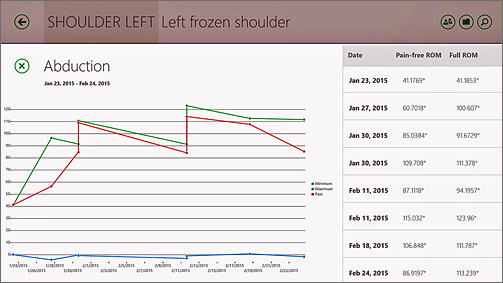Kinetisense brings objectivity to range of motion therapy
“Jane” had a problem: a so-called frozen shoulder, which made it painful to use her left arm. The pain, which had begun mysteriously eight months earlier, affected nearly every aspect of Jane’s life, making it difficult for her to perform routine tasks at her office job and at home.
She had tried a number traditional and alternative treatments, from massage therapy and stretching to acupuncture-like intramuscular stimulation and a soft-tissue treatment called myofascial release. None of these treatments provided meaningful relief, and Jane abandoned each out of disappointment. Emotionally exhausted by the seemingly incurable pain, Jane was prescribed antidepressants by her physician.
Then, as what he called a “last resort,” Jane’s physician referred her to chiropractor Ryan Comeau, one of the founders of Kinetisense, a Canadian company that has pioneered the use of Kinect for Windows v2 to record and track progress during physiotherapy for joint and range-of-motion problems.
Kinetisense’s software takes advantage of the Kinect v2 sensor’s ability to accurately record the exact position of body joints during therapeutic sessions. Unlike traditional methods of measuring joint angles, the Kinetisense system measures true joint values—based on the actual position of the bones—rather than approximating the angles formed by the external body parts.
https://www.youtube.com/watch?v=iR6huKucg6o
Kinetisense uses the Kinect v2 sensor to record the exact position of the body joints during therapy,
providing an unparalleled level of accuracy.
Kinetisense algorithms obtain the positions of the joints and calculate the exact angle of any given joint at any time. And it does this in less than half a second, without resorting to imprecise hand tools, such as inclinometers and goniometers, or expensive wearable equipment. The patient simply stands or sits in front of the v2 sensor and the Kinetisense software performs all of the necessary calculations with remarkable accuracy and speed. And because the sensor is measuring the true positions of the joints, Kinetisense provides accurate joint analysis even when patients unintentionally try to extend their range of motion by leaning, rather than relying solely on joint movement.
The objective accuracy of the Kinetisense measurements allows the practitioner to adjust the treatment and reach a more realistic prognosis. What’s more, Kinetisense helps with patient compliance, which is a well-documented problem in physiotherapy. And while there are several reasons for noncompliance, Comeau notes that, like Jane, “Many patients with range of motion problems drop out of therapy when they fail to discern a meaningful lessening of their pain. But because pain is a very subjective matter, many people perceive it as an “all or nothing” proposition—either the pain is gone or it has not lessened at all. People may, in fact, be experiencing real benefits from their therapy, but fail to realize it because they are not yet completely pain-free. Kinetisense helps by providing both the patient and the practitioner with graphs that demonstrate real progress in range of motion, even when the patient has yet to sense the improvement in terms of pain reduction. The realization that therapy is working is incredibly reinforcing to patients, who are then much more likely to continue their treatment."

The precise measurements of the joint angles enable Kinetisense to chart improvements in the
patient's range of motion. The quantifiable therapeutic results allow patients to see irrefutable
evidence of improvement.
Kinetisense meets the longstanding need for objectivity and evidence-based rehabilitation care—a boon to both the patient and the practitioner. And as for Jane, she’s continuing her treatment and shows ongoing improvement. She’s been able to reduce her antidepressant dosage by half, and has referred several friends and family members to Comeau’s practice.
The Kinect for Windows Team
Key links